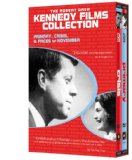| Reviews & Columns |
|
Reviews DVD TV on DVD Blu-ray 4K UHD International DVDs In Theaters Reviews by Studio Video Games Features Collector Series DVDs Easter Egg Database Interviews DVD Talk Radio Feature Articles Columns Anime Talk DVD Savant Horror DVDs The M.O.D. Squad Art House HD Talk Silent DVD
|
DVD Talk Forum |
|
|
| Resources |
|
DVD Price Search Customer Service #'s RCE Info Links |
|
Columns
|
|
|
Robert Drew Kennedy Films Collection, The
Now, five years on, Docudrama Films has re-packaged these DVDs in one two-disc box set entitled The Robert Drew Kennedy Films Collection, presumably to capitalize on the political fervor engendered by the 2008 general election. Those hoping that the films have been restored and the DVDs re-mastered will be sorely disappointed. Unfortunately, the only thing new here is the cardboard case.
If you're wondering who Robert Drew is, and why he gets top billing over Kennedy, he's the director, executive producer, editor, writer, creator, and owner of these films. Drew was instrumental in creating a camera with synchronized sound equipment light enough and quiet enough to permit a two-person film crew to document events wherever they occurred. To take advantage of the new equipment, Drew created Primary (53 min.), which is regarded as the first American Direct Cinema documentary. Primary captured the feel of a campaign in ways viewers had never experienced before. Two-man camera crews traveled with the candidates throughout the primary in Wisconsin recording them as they gave speeches, campaigned on the street, traveled from stop to stop, awaited the primary results, and spun those results to reporters.
To be properly appreciated now, Primary should be viewed in the context of its time. By present standards, Primary is burdened with a stridently emphatic narration that badly dates the film, technical difficulties that leave much of the sound out of sync with the image, and a decided lack of drama: on camera, the candidates neither interact with each other, nor with their campaign staffs or families. What we see is simply the candidates on the campaign trail, and little else. While this may be enough to satisfy people especially enamored with JFK's legacy, what makes Primary so fascinating for fans of documentary film is its technical innovation. When the camera crew follows directly behind Kennedy as he makes his way through a crowd of supporters to the podium, it's a breathtaking documentary first for what is now commonplace. When the camera tracks a beautiful young woman as she slyly gives Kennedy a flirtatious wink as they shake hands, that's a documentary first too, as is the sight of the Lt. Governor choosing to nap rather than converse with presidential candidate Senator Humphrey during a 30-minute car trip between campaign stops.
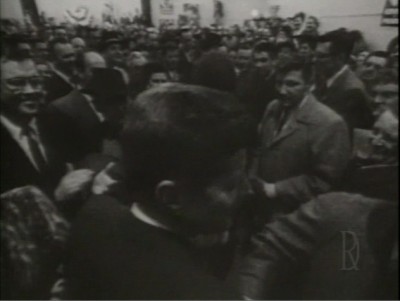
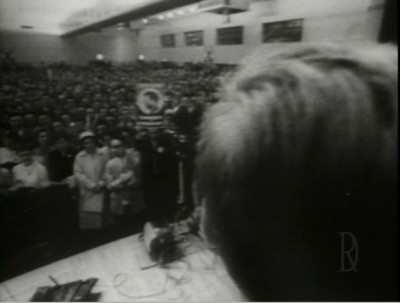
Undoubtedly one of the reasons for this re-release of Primary is the uncanny similarities between the 1960 Kennedy-Humphrey primary race and the 2008 Obama-McCain general race. Much like Obama now, Kennedy then was a charismatic, young, relatively-inexperienced junior senator drawing strong support from urban voters. And, much like McCain is now, Humphrey was a gruff, old, seasoned senior senator drawing his strongest support among suburban and rural voters. Though there are also obvious differences (e.g., Humphrey was politically to the left of Kennedy, while McCain is to the right of Obama), the sense of déjà vu is palpable when a Humphrey supporter denigrates Kennedy for his youth, inexperience and celebrity status.
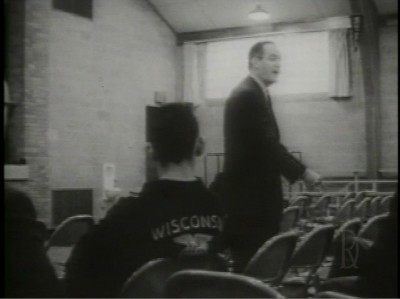
John F. Kennedy was nearly as pleased with how Primary turned out as he was with how the general election did. Consequently, he agreed in theory to allow Drew to make another film documenting how his administration responded to a crisis. However because international crises were considered too sensitive, the first situation considered suitable didn't occur until June, 1963 when Governor George Wallace refused to comply with a federal court order requiring the racial integration of the University of Alabama. President Kennedy tasked his brother, Attorney General Robert Kennedy with enforcing the court's desegregation order.
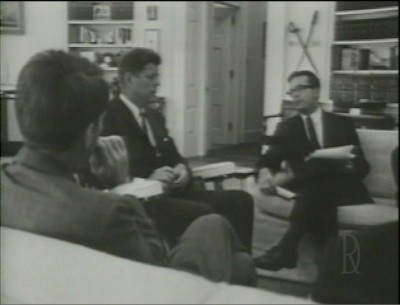
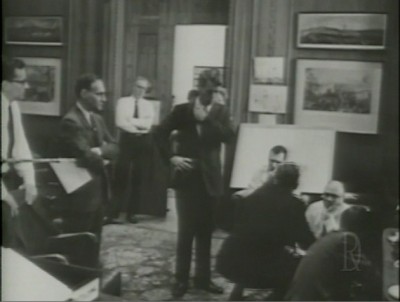
Crisis: Behind a Presidential Commitment (53 min.) is an order of magnitude superior to Primary in drama and technical quality. Crisis was shot with camera crews following Attorney General Robert Kennedy in Washington D.C., as well as Deputy A.G. Nicholas Katzenbach in Alabama, and even Governor Wallace, as they planned and executed their strategies. The sound synchronization problems that left Drew trying to match image with sound in post-production on Primary had been resolved, and even the low-light film stock looked to be much improved over that available three years earlier for Primary. The level of behind the scenes access given by the Kennedy Administration to Drew's camera crews for Crisis has never been matched since. Truly, the promise of Direct Cinema suggested by Primary was fulfilled by Crisis.
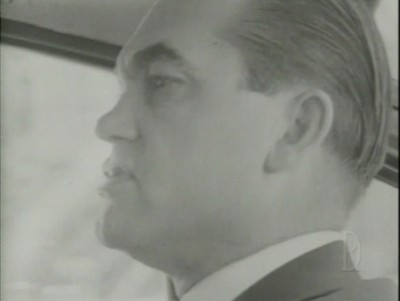
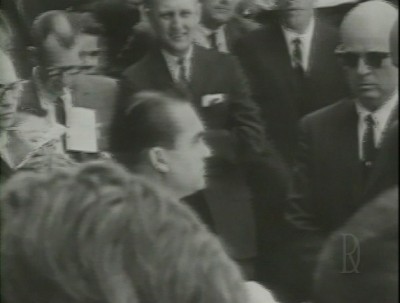
Rounding out the Drew documentaries in this set is the 11-minute short Faces of November documenting the outpouring of grief following the assassination of President Kennedy. Recorded on Sunday 22, 1963, this short was filmed in and around the Capitol Rotunda where the President's body lay in state. Opened to the public following a short ceremony with the Kennedy family, nearly 250,000 people passed through the Capitol to pay their respects between 9 AM on Sunday and 9 AM the following day. Faces of November is all the more powerful for its lack of narration.
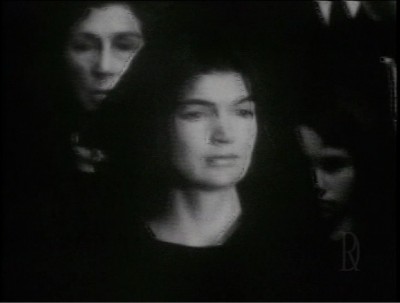
The DVD
Video:
If the original film materials had been lavishly restored and given the best analog to digital transfer possible, the image would still be far from ideal. Shooting with natural light, using lightweight 16mm cameras, with the film stock available at the time all but guaranteed a less than perfect image. The problems inherent in the original video, especially on Primary, include poor contrast, debris in the filmgate, and film that occasionally fails to line up properly in the camera leaving the bottom of each frame unexposed. Given the novel circumstances surrounding this effort, these problems are understandable. Unfortunately, these films haven't been lavishly restored, nor have they been given a good transfer. Damage to the film prints including dirt, splotches, and vertical scratches are readily apparent, as are significant compression artifacts attributable to the transfer. Most appalling of all, every frame of this set is stamped with Robert Drew's watermark as though it were merely some dreary television program on a third-rate cable station. The overall effect is brutally, and unforgivably ugly.
Audio:
The mono audio is directed to the left and right front speakers. The original audio recordings were far from ideal. Dialogue is sometimes indistinct either because the speaker is far from the mic, or because of background noise. Additionally, the video and audio for Primary are frequently out of sync, though this too is attributable to the original recordings. The weakness of the transfer appears to be limited to a failure to sufficiently reduce background noise, and a failure to provide optional subtitles.
Extras:
Robert Drew and photographer Richard Leacock provide audio commentaries for Primary and Crisis: Behind a Presidential Commitment. The Primary commentary is the more interesting of the two with Drew and Leacock admitting to being supporters of the more liberal Humphrey, and still sounding very proud of the technological innovativeness of that film, though they neglect to mention other pioneers of Direct Cinema and cinéma vérité outside of their colleagues on Primary: Terrence McCartney Filgate, D.A. Pennebaker, and Albert Maysles. On the Crisis commentary, Drew and Leacock frequently fall into silence and simply watch the film.
Two other featurettes originally made for the 2003 DVD release of Primary are The Originators: Recalling the Primary Breakthrough, a 27-minute panel discussion with Robert Drew, and photographers Richard Leacock, D.A. Pennebaker, and Albert Maysles about their work on Primary recorded in 2000 at the Sun Valley Center for the Arts in Idaho, and 30/15: 30 Years of Robert Drew Filmmaking in 15 Minutes which features brief excerpts from Drew's numerous documentaries without narration.
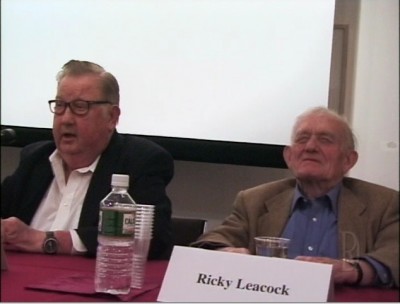
Final Thoughts:
The Robert Drew Kennedy Films Collection includes critically-important films that all students of documentary film history should see. Unfortunately, this set merely re-packages the flawed 2003 DVD releases. There's been no effort to restore the film prints or re-master the analog to digital transfers. Most egregiously, the horrendous Robert Drew watermark remains on every frame. If you haven't seen these films, my advice is to rent it, and wait for a better release.
Here's hoping for something better in 2013 to commemorate the 50th anniversary of JFK's passing.
|
| Popular Reviews |
| Sponsored Links |
|
|
| Sponsored Links |
|
|
| Release List | Reviews | Shop | Newsletter | Forum | DVD Giveaways | Blu-Ray | Advertise |
|
Copyright 2024 DVDTalk.com All Rights Reserved. Legal Info, Privacy Policy, Terms of Use,
Manage Preferences,
Your Privacy Choices | |||||||









